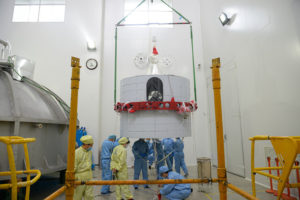
The launch of the Chinese meteorological satellite, Fengyun-2H, marks another step in the Chinese-led Space Silk Road, as Beijing dedicates the system to providing weather coverage along Belt and Road Initiative (BRI) territories.
Launched on Tuesday, 5 June 2018, the new Fengyun-2H meteorological satellite is expected to improve the accuracy of weather forecasting and provide better meteorological services to countries participating in the BRI. This was the 277th mission of the Long March rocket series.
A geostationary orbit satellite, Fengyun-2H is the last in the Fengyun-2 series.
According to Zhao Jian, deputy director of the Department of System Engineering of China National Space Administration (CNSA), the Fengyun-4 series will dominate China’s next generation of geostationary orbit meteorological satellites.
In response to a request from the World Meteorological Organization (WMO) and the Asia-Pacific Space Cooperation Organisation (APSCO), the position of Fengyun-2H will be changed from what was originally 86.5 degrees east longitude to 79 degrees east longitude. The adjustment will enable the Fengyun series satellites to acquire meteorological data over a wider range, improve weather forecasting accuracy and the ability to better cope with climate change monitoring, and help mitigate losses caused by natural disasters, Zhao said.
This means the Fengyun series satellites will be able to cover all the territory of China, as well as countries along the Belt and Road, the Indian Ocean and most African countries, according to the CNSA.
Equipped with a scanning radiometer and space environment monitor, Fengyun-2H will provide real time cloud and water vapor images and space weather information to clients in the Asia-Pacific region, said Wei Caiying, chief commander of the ground application system of Fengyun-2H and deputy director of the National Satellite Meteorological Centre.
The Belt and Road region, which is mainly high mountains, deserts and oceans, lacks significant meteorological coverage and information. Damage from natural disasters, especially meteorological disasters, in the region is more than double the world average. After four months of in-orbit tests, Fengyun-2H will provide data to help Belt and Road countries better cope with natural hazards, Zhao said.
“The move shows China’s willingness to construct a community with a shared future,” Zhao said in Xinhuanet.
It also addresses a WMO request to strengthen satellite observation of the Indian Ocean to fill a gap in the region, which is China’s contribution to the international community as a major power of the developing world, he said, adding that China will offer data of the Fengyun series free to Belt and Road countries and APSCO member countries.
China has helped establish ground stations to receive the Fengyun meteorological data in some APSCO member countries, including Pakistan, Indonesia, Thailand, Iran, and Mongolia. It plans to upgrade the stations and provide training to technicians in those countries.
Wei also explained that if countries along the Belt and Road are struck by disasters like typhoons, rainstorms, sandstorms, and forest or prairie fires, they can apply for and quickly get the data.
China’s meteorological satellites are already playing an important role in the Belt and Road region. In August 2017, the Fengyun-2E satellite captured an indication of heavy rainfall in Pakistan and issued a timely warning to avoid casualties from flooding.
China already has 17 Fengyun series meteorological satellites in space, with eight in operation, including five in geostationary orbit and three in polar orbit, to observe extreme weather, climate, and environment events around the globe.





